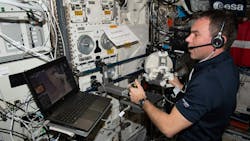ESA astronaut tests avatar control between ISS and Earth
COLOGNE, Germany - Concentrated silence reigns in the Mars laboratory of the German Aerospace Center (Deutsches Zentrum für Luft- und Raumfahrt; DLR) in Oberpfaffenhofen – the connection to the International Space Station ISS has been established. The 'Surface Avatar' experiment has been given the green light and Swedish ESA project astronaut Marcus Wandt is in orbit in the Columbus module commanding the first of three robots in the Earth-based Mars laboratory. Building on experiments carried out in July 2023, developers are testing in particular how time delays affect the control of robots during space missions. In the future, collaborative, intelligent robots will support spacefarers on exploration missions to the Moon or Mars, DLR reports. Continue reading original article.
The Military & Aerospace Electronics take:
21 February 2024 - "Future stations on the Moon and Mars, including astronaut habitats, will be built and maintained by robots operating under the guidance of astronauts. Our latest control and AI algorithms enable a single astronaut to command an entire team of different robots. Our DLR-ESA team is a world leader when it comes to this technology," says Alin Albu-Schäffer, Director of the DLR Institute of Robotics and Mechatronics.
The DLR robot Bert, resembling a dog, joined the team—a pioneering achievement in the field of telerobotics. Previously, only robots with wheel-driven mechanisms were remotely controlled from space by astronauts. However, Bert has acquired proficiency in various gaits and, owing to his leg-based locomotion, can navigate challenging terrains, including small caves inaccessible to his rolling counterparts. ESA project astronaut Marcus Wandt allowed his four-legged companion to independently explore the lab's surroundings and observe the terrain through his camera eyes. With Bert's 'running' data running in the background, Wandt shifted his focus to the other robots: DLR's humanoid service robot Rollin' Justin and ESA's Interact Rover.
Related: DLR develops mobile station for Satellite Laser Ranging
Related: DLR improves the prediction of flight characteristics for future aircraft
Related: NASA and DLR jointly developing quantum computer software package
Jamie Whitney, Senior Editor
Military + Aerospace Electronics
